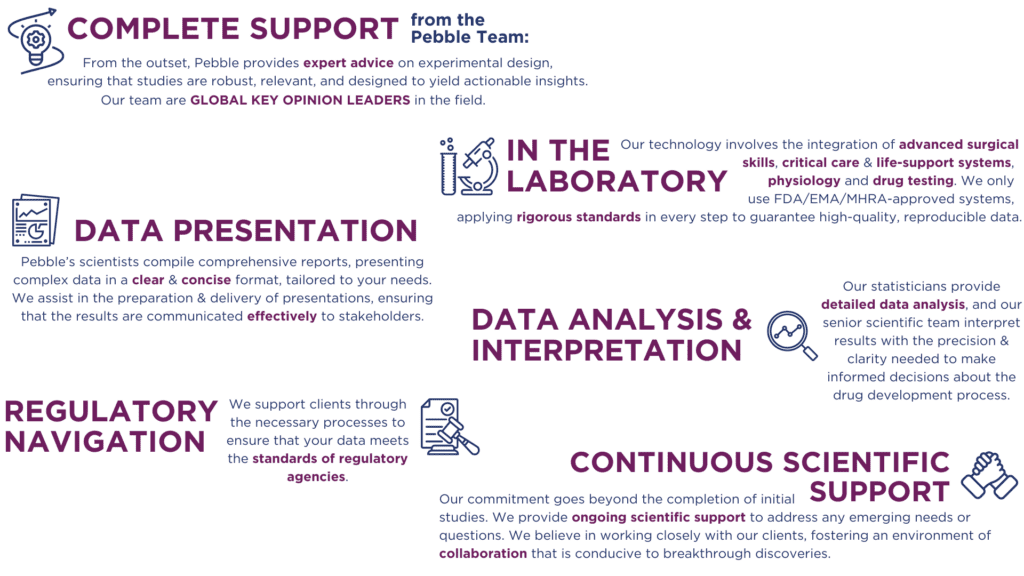The Drug Evaluation Hub
Pebble’s Drug Evaluation Hub provides a suite of preclinical assessment tools to streamline drug development processes. We generate pharmacokinetic, pharmacodynamic, and safety data in complex isolated, or, multi-organ interactions.


The Hub bridges the translational gap between experimental research and clinical application. Pebble’s LIVING-ORGAN systems closely replicate human physiology, delivering relevant insights that are critical for understanding drug safety and efficacy in the human body. This comprehensive analysis leads to refined dosing regimens, and predicts potential side effects, all within a controlled and efficient testing environment.
Why Use the Pebble Hub?

Iterative Refinement
Providing a unique framework for preclinical drug assessment, enabling iterative refinement without reporting early investigational results.

Rapid Outcomes
Early experimental outcomes serve to guide internal optimisations, with focus on developing successful therapeutics candidates.

Adapt with Data
We provide an environment where drug progression can be advanced or halted based on comprehensive data, prior to reaching regulated development stage.

Enhanced Decision Making
With Pebble, the preliminary stages of drug development are kept strictly in-house for strategic decision-making, enhancing the development process.

Optimise Clinical Potential
This tailored approach allows for strategic progression of drugs towards IND readiness, backed by data that supports your potential for clinical success.

Platforms
- Mapping multi-organ absorption, distribution, metabolism, and excretion (ADME) of drug candidates in individual and interconnected organs and tissues.
- Tailoring PK studies for organ specific physiology and biochemistry.
- Assessing first-pass metabolism in liver models and systemic circulation to evaluate bioavailability.
- Evaluating the impact of ocular barriers in eye models on drug absorption and local bioavailability.
- Investigating cross-talk between organs to understand drug effects and metabolism.
- Performing targeted PK profiling for site-specific drug delivery, including intramuscular and subdermal approaches in limb models.
- Investigate the influence of a fully functional immune system on drug kinetics, with specific focus on immune-modulating drugs.
- Profile kidney-model excretion patterns for renal drug clearance, and hepatic drug clearance in liver models.
- Quantify drug and metabolite concentrations in different tissue compartments to understand distribution within and between organs.
- Assess the immunomodulatory effects of treatments using integrated immune system models.
- Evaluate drug effects on organ haemodynamics and vascular integrity.
- Analyse drug effects on liver function, including bile production and enzyme regulation.
- Test the gastrointestinal influence of drugs on the gall bladder.
- Measure the influence of therapeutic agents on the spleen, focusing on blood filtration and immunological functions.
Kidney:
- Evaluate drug-induced renal cell injury using biomarkers like KIM-1, NGAL, and cystatin C.
- Monitor for changes in glomerular integrity and tubular function following drug exposure.
- Investigate mechanisms of drug-induced acute kidney injury and chronic kidney disease progression.
- Assess post-toxic renal recovery and regenerative capabilities in isolated and interconnected kidney models.
- Study the effects of repeated and chronic dosing on renal architecture and filtration capacity.
Liver:
- Quantify liver enzyme alterations to detect hepatocellular damage.
- Map the impact of drugs on liver metabolism and bile flow dynamics.
- Utilise the LIVING-LIVER to investigate hepatocyte apoptosis induced by toxic compounds.
- Examine hepatoprotective strategies and their ability to mitigate drug-induced liver injury.
- Analyse the liver’s role in systemic toxicity when integrated with other organ models.
Spleen:
- Investigate splenic filtration and immune cell populations in response to drug exposure.
- Assess the impact of drug exposure on splenic architecture and the potential for splenomegaly or hypersplenic changes.
Eye:
- Assess the effects of drugs on ocular pressure, fluid dynamics, and retinal health.
- Evaluate the potential for drug-induced ocular surface damage.
Limb:
- Evaluate the structural integrity of blood vessels and endothelial function in response to toxicological agents.
- Investigate the mechanisms of drug-induced vasculitis and thrombosis.
- Assess the effects of drugs on muscle health, including potential for myopathy.
- Evaluate the recovery of limb vascular and muscular function after exposure to toxic substances.
Multi-Organ:
- Create multi-LIVING-ORGAN scenarios to assess how drugs metabolised by one organ may become toxic to another, simulating whole-body responses.
- Introduce toxic agents across interconnected organ systems, then evaluate immune system activation and inflammatory responses.
- Investigate the compensatory mechanisms involved in multi-organ toxicity.
- Simulate clinical polypharmacy scenarios across different organs and evaluate DDIs.
- Investigate altered drug metabolism within the liver and determine enzyme induction or inhibition.
- Evaluate the impact of DDIs on immune function, particularly when combining immunosuppressants with other treatments.
- Investigate renal DDIs, with specific focus on drug metabolite excretion.
- Determine the implications of DDIs on pulmonary function, and assess treatments targeting respiratory conditions.
- Assess the impact of DDIs within an eye model, and measure ocular pressure and fluid dynamics in eye models, which are critical for glaucoma medication developments.
- Evaluate the interactions between blood components and drug administration in a circulating immune compartment.
- Examine the effects of DDIs on limb perfusion and vascular function, with emphasis on vasoactive drugs.
- Conduct nerve safety assessments with integrated limb and immune system models, which can identify reflexes and efferent/afferent responses.
- Utilise kidney models to examine to renal safety and detect changes in glomerular filtration rate and tubular reabsorption.
- Evaluate ocular safety, ensuring no impairment to eye structures.
- Study the immunological drug safety in models with immune system integration, monitoring for example, hypersensitivity, cytokine response syndrome or immunosuppression.
- Investigate liver function and drug safety, particularly focussed on hepatotoxicity and bile flow disturbances.
- Understand the potential impact of drugs on splenic structural integrity and function; an organ often overlooked in pharmacological safety.
After Non-Reportable Analysis - The Regulatory Pathway
The integration of ex-vivo systems in the regulatory pathway is of interest among regulatory agencies due to their potential to provide more predictive and human-relevant data than traditional in-vitro or animal models.
All components in Pebble’s LIVING-ORGAN systems are approved for use in humans across all regulatory authorities. Our blood biochemistry analysers and cartridges also have global approval for human use. This elevates the platform, and the robustness of the data we generate.
It is essential for any company or researcher using our systems to engage with regulatory agencies early in the drug development process through scientific advice procedures or pre-IND meetings. This ensures the generated data meets the requirements of the intended submissions. Pebble will work closely with you to ensure this is a success.
We Have the Skills

Testimonials

Dr Don Wellings
Managing Director
Spheritech
“We engaged with Pebble to conduct safety and toxicology studies on our haemoglobin-based oxygen carrier (HBOC) using their LIVING-ORGAN systems. Through a systematic test-fail-iterate-repeat approach, Pebble’s team provided invaluable insights into our HBOC’s performance. They identified its superior oxygen delivery capability, surpassing that of red blood cells, but also reported an issue with vasoconstriction. Pebble’s detailed analysis enabled us to understand the mechanism behind this problem, so we could modify our HBOC and resolve this issue. Subsequent evaluations revealed an interaction with red blood cells, prompting further refinement. This iterative process significantly accelerated our development timeline, improving our HBOC’s profile for clinical trial evaluation. The fact that this was all performed without using lab animals is also closely aligned to Spheritech’s working directives.”

